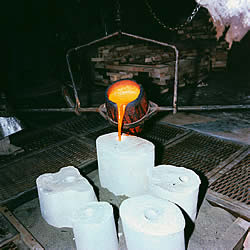Spying on precision castings
Precision castings at high melting temperatures need automatic monitoring and control of the smelt state during the casting process and of the solidification of the castings. The reactivity of the smelt and its interactions with the crucible material together with the melting time is a process parameter that significantly influences the quality of the casting. A combination of condition monitoring and control tools have been integrated to reveal the secrets of precision castings during their interaction with the crucible, up until complete solidification. Power signalling, acoustic measurements and optical methods were combined with the theory to monitor the complete casting process. The quantity of casting poor quality (or in the worst case; scrap) could reasonably be decreased by making the casting conditions more reproducible. Aimed at reproducing results of metallurgical quality and homogeneous castings, the method offers time and money savings as expensive finishing or recasting can be reduced to a reasonable level. The system can be used by any company producing precision castings as a monitoring strategy. It is powerful enough to represent an expert system and able to improve quality and minimise expensive scrap and rework.







